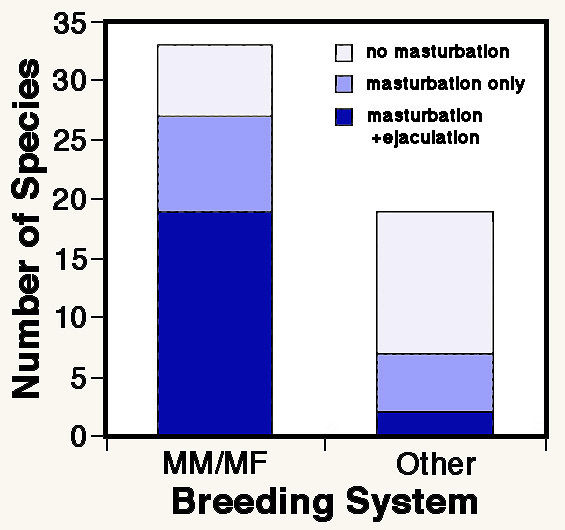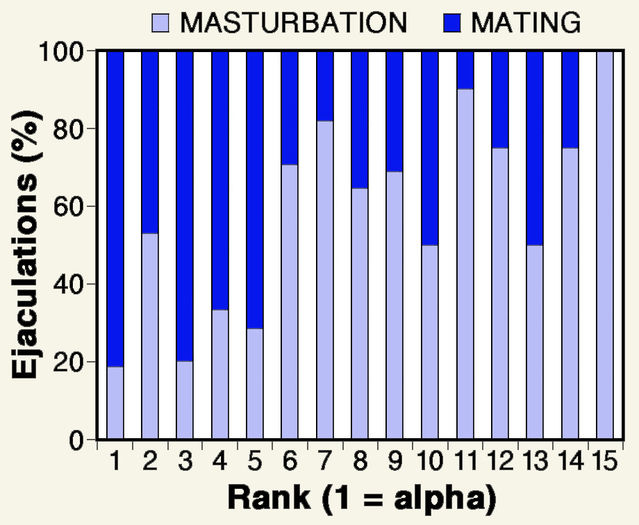Masturbation
Masturbation: Self-Abuse or Biological Necessity?
A dispassionate view of the natural history of self-gratification.
Posted November 16, 2017 Reviewed by Jessica Schrader

Despite greater tolerance, masturbation remains moderately taboo in Western society. Yet attitudes were also quite tolerant before the “Autoerotic Dark Ages,” an oppressive period lasting two centuries. Thomas Laqueur’s Solitary Sex. A Cultural History of Masturbation identifies the anonymous tract Onania, published around 1716, as a crucial turning point. The full title says it all: Onania: Or, the Heinous Sin of Self-Pollution and All its Frightful Consequences (in Both Sexes) Considered with Spiritual and Physical Advice to Those who have Already Injured Themselves by This Abominable Practice. Eradication of such nonsense began as the 20th Century dawned, and masturbation is now widely seen as not only harmless but actually beneficial. And evidence from nonhuman primates provides a valuable perspective.
Masturbation gets a bad rap
Confusingly, masturbation is often called “onanism.” The source, in Genesis 38:9, is the tale of Onan, duty-bound by custom to impregnate Tamar (widow of his brother Er) to ensure succession. Onan lay with Tamar, but withdrew and "spilled his seed” (a quaint description evoking incompetent gardeners). God slew Onan, but the crime was coitus interruptus, not masturbation, and motivated by inheritance issues. Ironically, masturbation seemingly did not count as evil in Onan’s time.

In the 18th Century, a deadly serious medical book entitled A Treatise on the Diseases Produced by Onanism gained widespread influence. Its author was Simon-André-David Tissot (aptly yielding the initials S.A.D.), an eminent Swiss physician and Fellow of the Royal Society of London. While dismissing large parts of Onania as “theological and moral frivolities," he meticulous cataloged dire effects attributed to masturbation—including epilepsy, blindness (!) and paralysis—citing his own patients and classical sources. In 1830, the slim French volume Le Livre sans Titre (Book Without a Name) graphically captured the ghastly outcome.
Possible benefits
Modern accounts indicate instead that masturbation is beneficial. In a thought-provoking 1975 essay, Roy Levin suggested that it might serve important functions by keeping semen volume within the normal range and reducing the frequency of abnormal sperms. Both effects would improve the chances of successful fertilization. Bear in mind that a man can also produce too many sperms, a condition known as polyspermy (see my August 11, 2017, post Why Too Many Sperms Spoil the Egg). Many studies have documented lower sperm counts when a man abstains for less than three days before semen sampling, so frequent ejaculation could reduce sperm counts below the polyspermy threshold.
A 2007 report by David Greening indicated that sperm DNA damage is reduced with frequent ejaculation. His pilot study examined 42 male partners in couples experiencing recurrent miscarriage or multiple failures of in vitro fertilization. Sperm DNA fragmentation was first assessed in semen samples collected after three days’ abstinence. Following a week with single ejaculations every day, DNA fragmentation was re-assessed. Total sperm counts, initially averaging around 200 million per ejaculate, declined by two thirds. However, DNA damage was reduced by about a third in 9 out of 10 cases. Greening concluded that increased ejaculation frequency may reduce DNA damage by reducing transit time of stored sperms.

Male masturbation in other species
Male masturbation is by no means unique to humans. It has been recorded for many mammals, ranging from bats to whales, both captive and wild-living. But masturbation is particularly common among male nonhuman primates, especially monkeys and apes. Discounting claims that masturbation is an aberrant behavior limited to caged primates, multiple reports stem from free-ranging populations. I often observed free-ranging male Barbary macaques on Gibraltar quietly sitting and masturbating. This was strikingly casual, provoking no overt response from other group members.

Ruth Thomsen published ground-breaking research on male masturbation in nonhuman primates in 2003 with co-authors Joseph Soltis and Christian Teltscher. Part of the research reviewed data from a survey among primatologists, documenting presence or absence of male masturbation for 52 species (35 wild-living or semi-free-ranging and 17 captive). One novel finding was that masturbation occurs not just in monkeys and apes, as previously thought, but also in 8 lower primate species. Male masturbation, recorded for two-thirds of the 52 species, is evidently not an artifact of captivity. Another key result was that masturbation is more common in primate species living in groups containing multiple adult males, and hence subject to sperm competition than in single-male groups (monogamous or polygynous). This fits the hypothesis that male masturbation flushes out low-quality sperms.

More detailed information emerged from extensive field research conducted by Thomsen and Soltis with free-ranging Japanese macaques on the Island of Yakushima. All 15 adult males in one study troop were seen masturbating, often to ejaculation. This species has a distinct breeding season. Unsurprisingly, masturbation was more frequent during the mating period, and no ejaculations occurred during the rest of the year. Male mating success correlated positively with social rank, whereas masturbation frequency increased as male rank declined, supporting the interpretation that masturbation is linked to lack of mating opportunity.
Capitalizing on their ability to collect semen samples from wild macaques, Thomsen and colleagues also analyzed their content. 128 masturbatory ejaculations were collected over nine mating seasons. An average volume of 2.2 ml was estimated for half of them, and sperm features were assessed for a third. Calculations revealed a very high total sperm count of over a billion per ejaculate. As is typical for species with marked sperm competition, the proportion with normal appearance in an ejaculate (94 percent) was also very high.
Female masturbation
So far, research has mainly examined male masturbation but it is important to recognize that female masturbation is also prevalent, not only in women but also in nonhuman primates. Surveys of women’s sexual behavior have repeatedly shown that masturbation is widespread, though universally less frequent than in men. Masturbation is also more frequent in males than in females among nonhuman primates. A yet unpublished MSc thesis by Elena Jones, co-supervised by Thomsen and Volker Sommer, reviewed masturbation in female nonhuman primates, noting its occurrence in 50 species. Brief mention of Jones’ findings by Thomsen in 2013 indicates that female masturbatory behaviors are often more sophisticated than those of males, including stimulation of the breast region as well as the entire anogenital region. However, it is difficult to gauge arousal because orgasm is far less overt in females than in males.
Of course, a crucial difference exists because male orgasm is needed for conception whereas its female counterpart is not (no “seed” is spilled). Accordingly, paralleling comments on female orgasm (see my September 13, 2016, post Intimately Connected), it is often suggested that female masturbation is simply a functionless byproduct of developmental pathways shared with the male. However, such an “explanation” is unconvincing. What we need is more scientific research into the little-explored realm of female masturbation and orgasm.
References
Anonymous (1756) Onania: Or, the Heinous Sin of Self-Pollution and All its Frightful Consequences (in Both Sexes) Considered with Spiritual and Physical Advice to Those who have Already Injured Themselves by this Abominable Practice. London: H. Cooke.
Greening, D.J. (2007) Frequent ejaculation: A pilot study of changes in sperm DNA damage and semen parameters using daily ejaculation. Fertility & Sterility 88:S19-S20.
Jones, E. (2005) Masturbation in Female Primates: Taxonomic Distribution, Proximate Causes and Potential Evolutionary Functions. (MSc Dissertation), University College London, London.
Levin, R.J. (1975) Masturbation and nocturnal emissions: Possible mechanisms for minimising teratospermie and hyperspermie in man. Medical Hypotheses 1:130-131.
Levin, R.J. (2007) Sexual activity, health and well-being: the beneficial roles of coitus and masturbation. Sexual & Relationship Therapy 22:135-148.
Laqueur, T.W. (2004) Solitary Sex. A Cultural History of Masturbation. Cambridge, MA: Zone Books (MIT Press).
Thomsen, R. (2013) Masturbation in non-human primates. In The Encyclopedia of Human Sexuality, Volume 1. Boston, MA: Wiley-Blackwell.
Thomsen, R. (2014) Non-invasive collection and analysis of semen in wild macaques. Primates 55:231-237.
Thomsen, R. & Soltis, J. (2004) Male masturbation in free-ranging Japanese macaques. International Journal of Primatology 25:1033-1041.
Thomsen, R., Soltis, J. & Teltscher, C. (2003). Sperm competition and the evolution of male masturbation in nonhuman primates. pp. 437-453 in: Sexual Selection and Reproductive Competition in Primates: New Perspectives and Directions (ed. Jones, C.B.). Norman, Oklahoma: American Society of Primatologists.
Thomsen, R. & Sommer, V. (2015) Masturbation in non-human primates. pp. 1-2 in: The International Encyclopedia of Human Sexuality, First Edition. (eds Whelehan, P. & Bolin, A.), Wiley-Blackwell Press, Boston.
Tissot, S.A.D. (1832) A Treatise on the Diseases Produced by Onanism. New York: Collins & Hannay.
For information provided by Jim Edmonson about Le Livre sans Titre, see: http://dittrick.blogspot.ch/2011/05/le-livre-sans-titre-1830.html




